PLANETOID BOMB
|
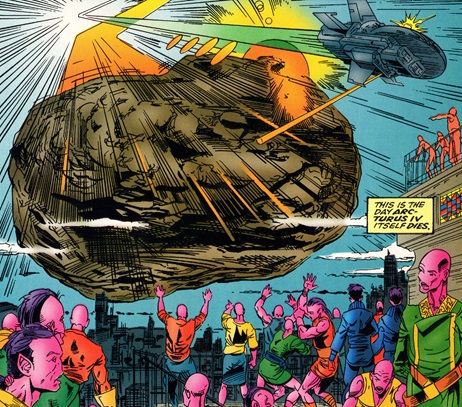 Classification: Extraterrestrial (Axi-Tun, with technology stolen from the Rigellians) technology Classification: Extraterrestrial (Axi-Tun, with technology stolen from the Rigellians) technology
Creator: Unrevealed
Possessors: Axi-Tun (notably the purification vessel ship commanded by Ramrog and assisted by astrogator Ghant)
First Appearance: (Unidentified)
Starmasters#1 (December, 1995);
(referenced as "Planet-Pulverizer)
Starmasters#2 (January, 1996);
(referenced as Planetoid Bomb) Starmasters#3 (February, 1996)
|
.
|
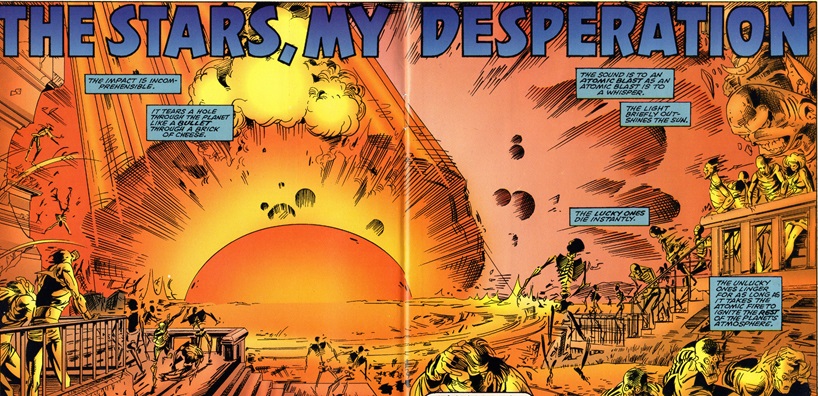
Powers/Abilities/Functions: The Planetoid Bomb (also known as the Planet-Pulverizer) was a ferrous
planetoid (500 miles in diameter) that -- via unrevealed means --
contained a black hole the size of a marble at its center, causing any
damaged fragments to be drawn back into its mass.
The mass and velocity of the
planetoid generated an "incomprehensible" impact, with the planetoid
tearing through a planet. The impact's sound was "to an atomic blast as
an atomic blast was to a whisper," and the light generated briefly
outshined the planet's sun.
Those closest to the impact
died instantly, while any others on the planet perished once the atomic
fire generated by the impact ignited the rest of the planet's
atmosphere.
Presumably this also
allowed it to replenish mass consumed during atmospheric entry from the
shattered nearby mass of the planet it struck. These properties allowed
the planetoid to be used repeatedly to destroy multiple worlds and then
recovered at its original mass thereafter.
The Planetoid Bomb was mobilized, directed, and
accelerated via a Rigellian Planet-Lock device, and it was apparently
given guidance and/or held in place until ready by multiple starships'
tractor beams.
History:
(Starmasters#3 (fb) - BTS / FF:
50 Fantastic Years) - Axi-Tun leader Votan’s agents stole a Rigellian
Planet-Lock device, with which they could transport and launch an
immense planetoid -- which contained a black hole at its center,
causing any damaged fragments to be drawn back into its mass -- to
cause extinction-level events on target worlds. The circumstances under which they created the Planetoid Bomb.
(Starmasters#1 (fb) - BTS) - Under direction
from Votan, Ramrog launched a planetoid to destroy six planets from
aboard his purification vessel.
(Starmasters#1 (fb) - BTS) - Whether via their
own Planet-Lock devices or via other technology, other Axi-Tun
purification vessels sought to exterminate other extraterrestrial
races, but none of them were close to the number set by Ramrog's
vessel/crew.
|
|
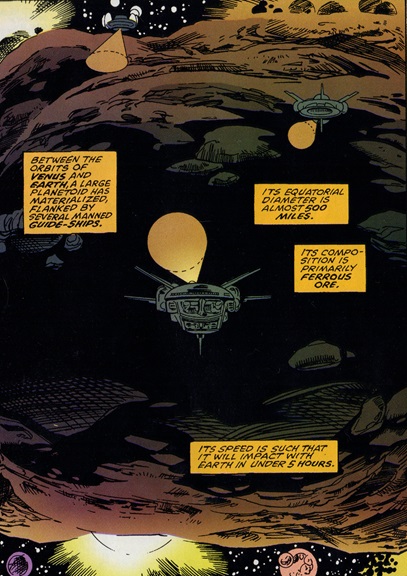
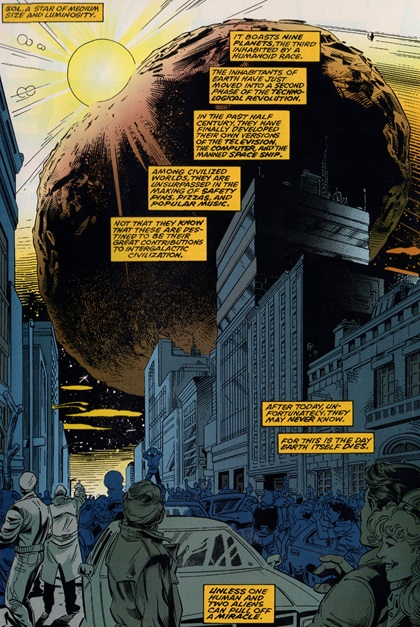 (Starmasters#1) - The Axi-Tun Votan's agent
Ramrog -- presumably via a Rigellian Planet-Lock device -- released a
giant planetoid hurtling into Arcturus IV, apparently destroying all
life on the planet. (Starmasters#1) - The Axi-Tun Votan's agent
Ramrog -- presumably via a Rigellian Planet-Lock device -- released a
giant planetoid hurtling into Arcturus IV, apparently destroying all
life on the planet.
Ramrog's astrogator Ghant notified him that all
"inferior life forms" on the planet were purged, after which they
prepared to recapture the planetoid.
Rather than enjoy his success,
Ramrog focused on the next target he had just been given: Earth.
Ramrog's ship later
materialized the ferrous planetoid between the
orbits of Venus and Earth, flanked by several manned guide-ships. Its
speed and course were such that it would impact Earth in under 5 hours.
Under Ramrog's orders, the guide-ships released the projectile, after
which Ramrog ordered all ships to retreat to hyper-space vantage point.
Nonetheless, Ramrog worried that Earth's resourceful superhumans might
foil their plot.
(Starmasters#2 - BTS) - The planetoid's
approach was detected by agents at San Diego's Mount Palomar's
observatory, wjere Anderson was instructed to verify the reading;
S.H.I.E.L.D. Radar Installation 10; and Avengers Headquarters Monitor
Room, where it was discussed by Peggy Carter, the Black Widow (Natasha
Romanoff), and the Vision (Victor Shade), the latter of whom noted that
an object of this mass could not have approached this close to Earth
without prior detection, which would indicate that it in some manner
had materialized there.
The Black Widow wondered what, if anything, it
had to do with the "We Come In Peace" message that appeared above Earth
12 hours before (which had been a legitimate peace message sent by the
Charter Federation prior to their slaughter, secretly at the hands of
the Axi-Tun).
ABC News' correspondent
Bruce McCauley subsequently reported the approach of the "meteor";
hearing this report, Lisa and Gayle Vaughn considered that this was a job of their son and brother, respectively.
|
.
.
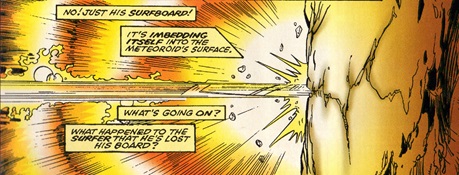 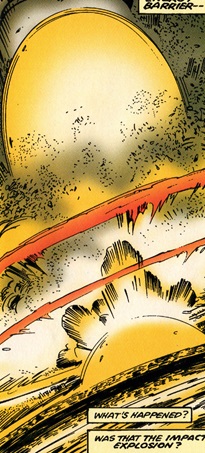
Stenth relayed the
instruction to Command Central, and an apparent Axi-Tun superior ordered Morfex
to not assist in destroying the planetoid but to follow orders and capture
Quasar.
Morfex nonetheless ordered Stenth to fire the beam at the planetoid,
allegedly in order to flush out Quasar on the planetoid; when Stenth delayed,
Morfex cast him aside and fired the beam himself.
Stenth soon after struck Morfex from
behind with a handblaster (hitting, not blasting), knocking Morfex out and
exposing him as a Skrull, after which Stenth cast Morfex out into open space,
naming himself as the new Squadron Leader.
Xenith saved Morfex, who
revealed the treachery in the Charter, and the Beta Ray Bill, Quasar,
and the Silver Surfer destroyed the planetoid, presumably been weakened by the decohesion beam.
This was accomplished
largely due to the Surfer briefly reactivating the barrier that
Galactus had previously used to imprison the Surfer on Earth and then imbedded his
surfboard within the planetoid, causing it to be affected by and crash into and be shattered by the
barrier.
|
.
.
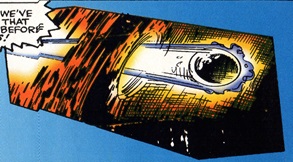 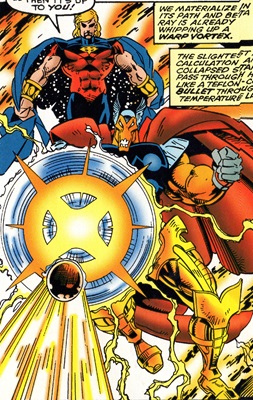 The black hole, unaffected by the previous impact,
continued through Galactus' barrier, heading toward Earth. The black hole, unaffected by the previous impact,
continued through Galactus' barrier, heading toward Earth.
Quasar then
teleported Beta Ray Bill and himself in front of the black hole, and
Bill then formed an interdimensional portal through which he
banished the black hole previously at the planetoid's center.
(Starmasters#3 - BTS) - Aldebron reported to Votan the failure of the Planet-Pulverizer
against Earth.
(Starmasters#3 - BTS) - Shortly after Ghant informed Ramrog that Earth had survived
their planetoid bomb, Votan contacted them and ordered they purify themselves to
atone for their failure.
They complied, blowing up their ship and killing
themselves and anyone else aboard.
(Starmasters#3) - Prime
Administrator Tana Nile led a group of three organic beings and 24
Recorders to the Hub to investigate the cause of the deaths of the
Charter delegates.
When
Recorder#901 reported that the Hub's telemetric system recorded a
disturbance by Earth, Tana instructed 901 to contact Rigellian High
Command and determine if any of their Planet-Lock devices had been
reported stolen or missing.
|
Comments: Created by Mark Gruenwald, Scot Eaton, and Bob Almond.
The Axi-Tun's theft of a Rigellian
Planet-Lock device was speculated by Tana Nile in Star Masters#3 and
confirmed in the Axi-Tun profile in FF: 50 Fantastic Years
Here's some physics/mass
information courtesy of Mike "Spider-Mike" Fichera, the engineer of the
Official Handbook of the Marvel Universe group:
I/Snood provided the misinformation that the planet was spherical, when some make it look more like a rectangular prism
Mass of the planetoid
Assuming a density
similar to Earth (mostly iron and nickel):
5.51 metric
tonnes/cubic meter (1 tonnes = 1 metric ton = 1000 kg)
diameter: 500
miles (Earth is 7918 miles)
mass of planetoid:
1.503 x 10^21 kg
1.66 x 10^18 tons
(English units)
If it's ALL iron (a
"ferrous" planetoid), and not a mix, the density is 7.87 MT/m³ and
therefore
2.37 x 10^18 tons mass
This site -- https://earthhow.com/density-of-earth -- says the Earth is:
- Iron (35%)
- Oxygen (30%)
- Silicon (15%)
- Magnesium (13%)
but the density varies
by which layer you are looking at. More dense in the chocolatey crunchy
center!
Whatever -- more info
than you need.
If like Earth - use
the first #.
If all iron, use the
second.
I believe the planetoid was solid iron and
artificially-created, perhaps by gathering the iron portions of
progressively larger asteroids, moons, etc.
--Snood
Mass including the black hole:
Ignoring
the theoretical "black holes have zero volume and infinite density"
bit - I saw one estimate of 4 x 10^14 g/cm³ for a black hole
density.
Let's
go with that.
Marble
= half inch diameter
Volume
= 1.07 x 10^-6 m³
Mass:
4.73 x 10^8 tons
Added
together: too many decimals apart to see the contribution of the black
hole.
2.37
x 10^18 + 4.73 x 10^8 = 2.37 x 10^18
Answer
is still: 2.37 x 10^18 tons mass for an all iron planetoid.
Further discussion on the science and practicality of the Planetoid Bomb courtesy of Donald Campbell:
Part One: The Planetoid-Bomb
First, in Starmasters#1, Captain Ramrog and his
crew referenced their weapon only as "the projectile."
I went to Wikipedia
to check out its list of exceptional asteroids. At almost 500 miles wide, the
planetoid fits between the top two asteroids with the greatest diameters:
somewhat narrower than Ceres (at 584 miles) but significantly wider than Vesta
(at 326 miles).
Of course, even though Ceres is wider than the
planetoid-bomb, the fact that about a quarter of its mass is water ice makes it
less than one-third as dense as the ferrous planetoid. This means that the
planetoid-bomb would be much more massive and therefore the energy it would
release upon impacting Earth would similarly have been much greater. The energy
with which a moving object (the impactor) strikes another object is
proportional to product of the mass of the impactor and the square of its
velocity at impact, so the speed at which the planetoid-bomb was moving would
have been more significant than its mass.
Unfortunately, it's impossible to calculate how
fast the Planetoid Bomb was traveling because the story in Starmasters#1-2
doesn't provide specific values for the two factors needed to calculate speed.
Being told that the planetoid would impact Earth in less than 5 hours is one
thing, but stating that it materialized between the orbits of Venus and Earth
is so imprecise as to be useless. Assuming that what the story had meant to say
was that the planetoid had materialized somewhere between Earth and the part of
the orbit of Venus that was then closest to Earth, that distance would be, on
average, about 25 million miles (but that can vary somewhat since both planets
have elliptical orbits). So, if the planetoid appeared about 5,000 miles away,
then its speed would have been about 1,000 miles per hour (or about 0.278 miles
per second). If the planetoid had appeared midway between Earth and the orbit
of Venus, about 12.5 million miles, then its speed would have been about 2.5
million miles per hour (or about 694 miles per second). Finally, if planetoid
had appeared the full 25 million miles away, then its speed would have had to
have been 5 million miles per hour (or about 1,389 miles per second) in order
for it to have impacted Earth in less than 5 hours.
Of course, considering how close to Earth the
planetoid was shown to be on page 2 of Starmasters#2, a really slow speed seems
more likely, but the possibility that the artwork did not accurately represent
how close the planetoid was to Earth at that time cannot be ignored. After all,
page 1 of that issue showed the Moon and Earth being far closer to each other
than they ever would be in real life. In contrast, the letters page of Quasar#6
did show images of the two bodies that were drawn to their correct size and
distance, and accurately showed that the distance between them was about 30
Earth diameters.
On a related topic, the last page of
Starmasters#1 is a full-page image of the planetoid that appears to be looming
over an unidentified city on Earth. In order to appear as large in the sky as it
does, that planetoid would have to have been incredibly close to Earth, as in
"only a matter of seconds before impact" close. This is inconsistent
with the fact that, in Starmasters#2, Quasar, the Silver Surfer and Beta Ray
Bill were able to spend minutes whittling down the meteoroid to half its
original size.
--I think that showing the planetoid that close to Earth was artistic license to dramatize the threat.--Snood
By the way, considering how quickly that trio
can travel, they should have been able to reach the vicinity of the meteoroid
with more than 4 hours to spare, so where did the time go? The total elapsed
time that they spent blasting the meteoroid and battling the Cosmic Commandos
seems to have been only a matter of minutes, not hours.
Given that the purification vessel shown guiding
the projectile immediately before it impacts the surface of Arcturus IV appears
to not be that much smaller than the asteroid itself, does this mean that the
purification vessel was similarly huge, as in hundreds of miles across? Or did
they use a smaller projectile against Arcturus IV? Or maybe the artwork just
did not accurately represent the proper scale of the two objects with respect
to one another?
--I think the latter, or possibly the ship was a lot closer than it initially appeared--Snood
The fact that the planetoid was described as
having "(torn) a hole through the planet (Arcturus IV) like a bullet
through a brick of cheese" does seem to suggest that "the
projectile" did pass entirely through the planet and was thus was
available to be recaptured by Captain Ramrog's purification vessel to be used
against other targets. However, while I'm willing to concede that that may have
been writer Mark Gruenwald's intent, I strongly doubt that any planetoid, even
one with a tiny black hole at its center, would have been able to avoid being
vaporized by such an impact. The black hole's gravity may have helped hold the
meteoroid together, but it wouldn't have done anything to protect the matter of
the meteoroid from the energy that would have been released when its kinetic
energy had been converted into heat upon impact. The planetoid should have been
completely vaporized while the tiny black hole had just, as Quasar put it,
passed through the planet "like a Teflon-coated bullet through room temperature
lasagne."
While every meteoroid that is known to have
encountered Earth has been vaporized, either through ablation while passing
through the atmosphere or upon impact, all of them were less than 10 miles in
diameter and thus far smaller than the planetoid-bomb. On the other hand, the
largest object believed to have ever struck Earth after its initial formation
4.5 billion years ago is Theia, a hypothetical Mars-sized planet whose giant
impact with Earth is believed to have resulted in the creation of the Moon. However,
even Theia isn't believed to have passed through Earth.
As to the question of whether the Planetoid-Bomb
was reusable, I have always thought that the projectile that the purification
vessel recaptured after Arcturus IV was destroyed was the tiny black hole and
that they had then embedded it within a new planetoid. However, the fact that
Captain Ramrog seemingly ordered the astrogator to set course for Sol III so
soon after the projectile had been recaptured does suggest that there hadn't
been enough time for them to acquire another planetoid from the Arcturus system.
On the other hand, maybe the "planetoid " was actually a ferrous
chunk of Arcturus IV itself? That would, sort of, be what the story implied.
Anyway, the only thing we know for certain about the planet-pulverizer that
failed to destroy Earth was that it was, as a Recorder told Tana Nile in
Starmasters#3, "a planetoid originating outside this planetary
system."
--I think that the
planetoid's mass was reconstructed from the planets it destroyed each
time. I don't think that was outright confirmed, but it makes the most
sense to me--Snood
The idea that the Silver Surfer was able to stop
the meteoroid by embedding his surfboard into its surface and then reactivating
the barrier that Galactus had once placed around Earth is interesting, but I'm
not sure how well it really would have worked. For one thing, the entire
stopping force of the barrier would have been concentrated solely on the
surfboard and one would think that that, instead of stopping the whole
meteoroid, would have simply driven the surfboard into and through the
meteoroid, punching a hole through it but not otherwise impeding it much. Of
course, it's always possible that the Surfer did something that somehow
prevented that from happening, but it would have been nice if the story had
mentioned that. Also, the impact with the barrier seemed to have shattered the
meteoroid into smaller fragments, all of which would no longer have been
stopped by the barrier. This would have left them free to continue falling down
upon the Earth, and would have required the heroes to take some quick action
Unless, by some lucky chance, the fragments were somehow all so small that they
would burn up in the atmosphere?
--Definitely some
"comic book sci-fi" going on here. I had the same first thought,
wondering why the surfboard didn't stop, but the planet keep going,
just driving the surfboard through the planetoid (and then who knows
what would have happened when the surfboard hit the black hole). I
think perhaps the Surfer was able to extend his surfboard's energy
field across the striking surface of the planet so that the barrier
recognized/blocked the whole planetoid. That's the only
explanation I've got.--Snood
Fun fact: According to Wikipedia, Ceres and
Vesta together contain about 50% of the total mass of all known asteroids and
scientists have estimated that that total mass is only equivalent to about 3%
of the mass of Earth's Moon. Scientists also believe that the modern-day
asteroid belt contains only a small fraction of the mass of the primordial
asteroid belt and that the total mass of the original asteroid belt may have
been similar to that of Earth but that gravitational perturbations ejected over
99% of that material within about one million years of the belt's formation. In
other words, there was never a "fifth planet" located between Mars
and Jupiter, at least, not in the real world.
Additionally, while researching asteroid impacts
online, I read somewhere that "NASA has calculated that an asteroid 60
miles (97 km) in diameter would wipe out all life on Earth as in burn us alive
so it gets the bacteria too. Actually, there are bacteria deep in the ground so
it wouldn’t wipe out all life but it would get all life on the surface."
So, using a 500-mile-wide planetoid against Earth was
definitely a case of overkill.
Part Two: The Tiny Black Hole
While having a black hole inside the
Planetoid-Bomb may have helped keep it together, it would have also vastly
increased the amount of mass that the purification vessel would have had to
move in order to launch/guide the Planetoid-Bomb. There's also the question of
exactly how the Axi-Tun would have been able to keep it at the center of the
planetoid since there could not have been any physical connections between them
because any matter from the planetoid that got too close to the tiny black
hole's event horizon would have been sucked into it. Given that they would thus
have been two separate masses, each with their own momentum, one would expect
that any changes to the course of the planetoid would have resulted in the
black hole simply continuing forward on its own course and passing through the
side of the planetoid as it turned.
Not having the skills needed to calculate the
mass of a tiny (or marble-sized) black hole, I chose to seek answers online.
According to someone on Quora, a black hole with the mass of the earth would be
about the size of a marble. However, I also found a podcast in which
astrophysicist Neil deGrasse Tyson stated that "an Earth-mass black
hole...is about the size of a plum" and a video in which astronomer Phil
Plait stated that, if the Earth were turned into a black hole, it would measure
about 18 millimeters across. Not knowing which statement was the most
accurate, I decided to take the possibility that the tiny black hole had
the same mass as Earth and do some calculations of my own.
It has been established that the force of
gravity at Earth's surface, 3959 miles from its center of mass, is "1
g." So, given that the gravitational force is inversely proportional to
the distance between the centers of mass squared, it should be fairly easy to
calculate the g-force that would be exerted on someone who was standing on the
surface of a 500-mile-wide planetoid with an Earth-mass black hole at its
center. Since the radius of the planetoid was about 250 miles, or roughly
one-sixteenth the radius of Earth, the distance squared would have been reduced
to 1/16 squared (or 1/256). And since dividing by a faction is the same as
multiplying by the inverse of that fraction, the g-force on the surface of that
planetoid would have been about 256 g. Until I had actually worked out that
calculation, I had never really believed that chunks that had been blasted off
the planetoid could have been pulled back to rejoin the main mass of planetoid,
but it turns out that I was wrong.
Of course, if the mass of the tiny black hole
had been anywhere near the mass of Earth, its presence within Earth's Roche
Limit would have meant that its gravity would have begun tearing the planet
apart even before Beta Ray Bill was able to create a warp vortex to send it a
million light-years away. The fact that Earth was seemingly unaffected by the
black hole's proximity suggests that its mass was actually much less than that
of Earth.
Normal stellar black holes are formed when stars
at least eight times as massive as the Sun explode as supernovas and their
cores collapse into black holes. However, since the event horizons of even the
smallest of this type of black hole are over fifty kilometers across, the tiny
marble-sized black hole could not have been one of that type. The only possible
explanation is that that particular black hole was actually one of the
(theoretical) primordial black holes that astrophysicists believe might have been
created in the earliest moments of the universe, when all matter and energy
were compressed into an incomprehensibly-dense region.
I
don't have much to contribute to this discussion other than the mass
calculation/explanation provided by Mike Fichera above.--Snood
Part Three: The Rigellian Planet-Lock Device
This profile takes it as fact that agents
working for Axi-Tun leader Lord Votan had stolen a Rigellian Planet-Lock Device
and that Captain Ramrog's purification vessel was equipped with that device
which they used to capture, transport and launch immense planetoids at their
chosen planetary targets. And, yes, I am aware that the Axi-Tun profile in FF:
Fifty Fantastic Years#1 does confirm that that was how Ramrog and his crew were
able to control their Planetoid-Bomb.
The problem is, I just don't believe it. Yes,
when informed by that Recorder that Earth had recently experienced a near
collision with a planetoid from outside the Solar System, Tana Nile did
immediately order the Recorder to contact Rigellian High Command and determine
if any of their Planet-Lock Devices had been reported stolen or missing, but
that's the only mention of such a device that appears in the entire five-issue
storyline. It appears to me to be mere speculation on Tana Nile's part, based
solely on the fact that she was aware of the capabilities of such Rigellian
devices and wanted to know if one of them could have been responsible. Now, if
there had been the slightest hint in the remaining two parts of the storyline
that a Planet-Lock Device had been used by Ramrog and his crew, then I would
have no problem accepting that idea. However, as it is, I believe that Mark
Gruenwald included that reference as a bit of continuity trivia that would be
appreciated by those readers who were familiar with Tana Nile and might have
known of her previous experience with moving planets.
Regardless, that was the only explanation proposed in-story, and it is
the official explanation until some new story comes along to contradict
or more clearly explain what happened. I wish we could ask Gru for an
explanation.--Snood
Part Four: The Rigellian Space Lock
This was the spaceborne device that Tana Nile
had begun to use (in Thor I#131-133) to slowly pull Earth out of its natural
orbit during her attempt to take over the planet. As presented in those issues,
the Space Lock was a single massive device that could project a ray
instantaneously across interstellar space. Once a planet had been completely
encircled by the Space Lock beam, the controller of the Space Lock could then
transport the captive planet to any location in the universe.
Although exactly how the Space Lock functioned
was never revealed, the fact that it was able to move planets by itself is one
of the reasons why I strongly disbelieve that Captain Ramrog's purification
vessel, which seemingly needed to use guide-ships equipped with tractor beams
to move their Planetoid-Bomb, was using a Planet-Lock. Of course, this is
assuming that the Planet-Lock Device mentioned by Tana Nile is the same
technology as the Space Lock that she had once used against Earth, something
that I don't think has ever been confirmed.
The Space Lock has never appeared in any story
published since 1966. At least, not under that name...
--I think the Planet-Lock is how they teleported/materialized the
planet to a new solar system, and then the tractor beams were used for
fine direction control. But, yes, we don't know the exact connection
between the Space Lock, the Planet-Lock, and the Planetary Defense
System.
I am working on a profile for the Rigellian Space Lock device, and I
will most likely include sub-profiles on the Planet-Lock Device and the
Planetary Defense System--Snood
5. Planetary Defense System/Planetary
teleportational defense
In Thanos I#1, writer Jim Starlin introduced the
idea that the major defense system of the Rigellian Colonizers was their
ability to teleport their entire planet as far away as another galaxy in order
to escape any threat. Thanos also mentioned that the Rigellians used that
technology to discipline any unruly planets that they colonized, something that
sounds very similar to the Space Lock. However, the actual technology involved
was never depicted in-story, even when Thanos used it to transport old Rigel-3
(the second known Rigel-3) into close proximity to Rigel-18 in order to stop Hunger.
Your question about why the Rigellians didn't
use their Space Lock technology and/or their Planet-Lock Devices against the
Black Stars is a valid one, and the most likely real world answer is that the
idea simply never occurred to writer Gerry Conway back in 1973. Even though
Tana Nile appeared in Thor I#218-220, maybe he hadn't read Thor I#131-133?
However, like you, I am at a loss for an in-universe explanation for this
oversight.
Having said that, your question caused me to
think of another question: If the Rigellians could safely move planets with their
Space Lock, why couldn't they have used its beam to transport Rigel-3 itself
far away from the threat of the Black Stars? One would think that, if it was
actually the same (or similar) technology as their planetary teleportational
defense, then using it would have made it unnecessary to evacuate all nine
billion Rigellians from their command planet in a fleet of over seven hundred
starships. It would also have made the evacuation of the subsequent Command
Planet in Thor I#423 unnecessary.
Profile by Snood.
CLARIFICATIONS:
The Planetoid Bomb should be distinguished from:
- PLANET-DESTROYER - creation of Sagittarians, placed on Earth in Savage
Land to slowly stop Earth’s rotation to cause its destruction for Galaxy Master, guarded by
Umbu, deactivated by Bruce Banner--Incredible Hulk II#109
- PLANETFALL WEAPON - derived from the genome of an otariidae predator genus
native to Turakis, unleashed by Turakisites in response to Annihilation Wave but
they were unable to regain control of it afterward, destroyed by Nova (Rich
Rider)--Nova IV#1 (1d)
- PLANET GUN of Earth-928 circa 2099 A.D. - spaceship used by Vendetta + Punisher--Punisher 2099#31
- PLANET-KILLER - weapon of Maraud, used to destroy Kymellia II - GALACTUS-MATIC*--Power Pack I#50 (51, 52
- PLANET THRUSTER - Starblasters weapon, push a planet out of orbit, or squish a planet between two of them--Namor I#46
- SIDERAL PROPULSION UNIT - placed on Ego by Galactus, initially sending him flying out of control, but eventually taken control of by Ego--Thor I#228?
- other Planet or Planetoid weapons, technology, characters, groups, events, races or places...
images: (without ads):
Star Masters#1, pg. 1, panel 5 (planetoid directed to crash into Artcurus IV);
pg. 2-3,
panel 1 (asteroid crashing into and destroying all life on Arcturus IV);
2nd to last page, panel 1 (planetoid with guide-ships);
last page (planetoid approaching Earth);
#2, story pg. 2, panel 1-2 (Beta Ray Bill, Quasar, & Silver Surfer approaching and blasting planetoid bomb);
pg. 3, panel 1-2 (struck with combined power of Beta Ray Bill, Quasar,
& Silver Surfer; reassembling);
pg. 15, panel 4 (Surfer's surfboard striking planetoid);
pg. 16, panel 6 (impacting Galactus' barrier);
pg. 18, panel 1-2 (black hole pentrating Galactus' barrier, approaching
Beta Ray Bill's dimensional vortex);
Appearances:
Starmasters#1 (December, 1995) - Mark Gruenwald (writer), Scot Eaton (penciler), Bob Almond (inker), Ralph Macchio (editor)
Starmasters#2 (January, 1996) - Mark Gruenwald (writer), Scot Eaton (penciler), Bob Almond (inker), Ralph Macchio (editor)
Starmasters#3 (February, 1996) - Mark Gruenwald (writer), Scot Eaton (penciler), Don Hudson (inker), Ralph Macchio (editor)
FF Fifty Fantastic Years#1 (November,
2011) - Jeff Christiansen, Mike O'Sullivan & Stuart Vandal (head
writers/coordinators), Markus Raymond & Mike Fichera (assistant
coordinators), Sean McQuaid, Madison Carter, Markus Raymond, Ronald
Byrd, Patrick Duke, Kevin Garcia, Anthony Cotilletta, Roger Ott, Rob
London, Seth Johnson & Eduardo Frye (writers), Gus Vasquez
& Andrew Dalhouse (select character artwork), Theodore W. Kutt (copy editor), James Emmett & Joe
Hochstein (editorial assistants), Alex Starbuck & Nelson Ribeiro
(assistant editors), Jennifer Grunwald & Mark D. Beazley (editors,
special projects), Jeff Youngquist (editor)
Any Additions/Corrections? please let me know.
First posted: 04/05/2024
Last updated: 04/05/2024
Non-Marvel Copyright info
All other characters mentioned or pictured are ™ and
© 1941-2099 Marvel Characters, Inc. All Rights Reserved. If you
like this stuff, you should check out the real thing!
Please visit The Marvel Official Site at: http://www.marvel.com
Special Thanks to
www.g-mart.com for hosting the Appendix, Master List, etc.!
Back to Items
 Classification: Extraterrestrial (Axi-Tun, with technology stolen from the Rigellians) technology
Classification: Extraterrestrial (Axi-Tun, with technology stolen from the Rigellians) technology

 (Starmasters#1) - The Axi-Tun Votan's agent
Ramrog -- presumably via a Rigellian Planet-Lock device -- released a
giant planetoid hurtling into Arcturus IV, apparently destroying all
life on the planet.
(Starmasters#1) - The Axi-Tun Votan's agent
Ramrog -- presumably via a Rigellian Planet-Lock device -- released a
giant planetoid hurtling into Arcturus IV, apparently destroying all
life on the planet. 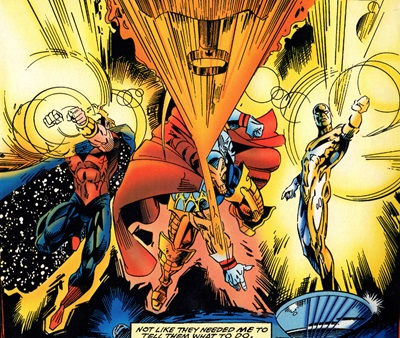
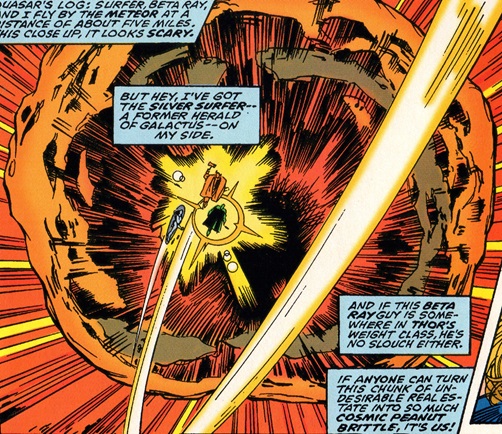 (Starmasters#2) - Beta Ray Bill, Quasar, and the Silver
Surfer attempted to destroy the planetoid, but the gravity from its internal black hole reassembled any damaged parts.
(Starmasters#2) - Beta Ray Bill, Quasar, and the Silver
Surfer attempted to destroy the planetoid, but the gravity from its internal black hole reassembled any damaged parts.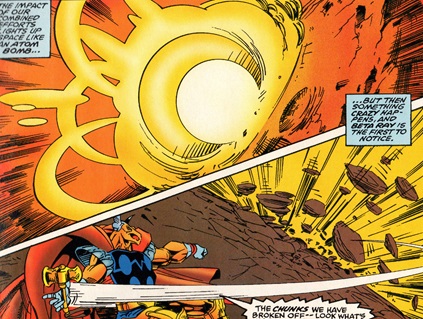



 The black hole, unaffected by the previous impact,
continued through Galactus' barrier, heading toward Earth.
The black hole, unaffected by the previous impact,
continued through Galactus' barrier, heading toward Earth.